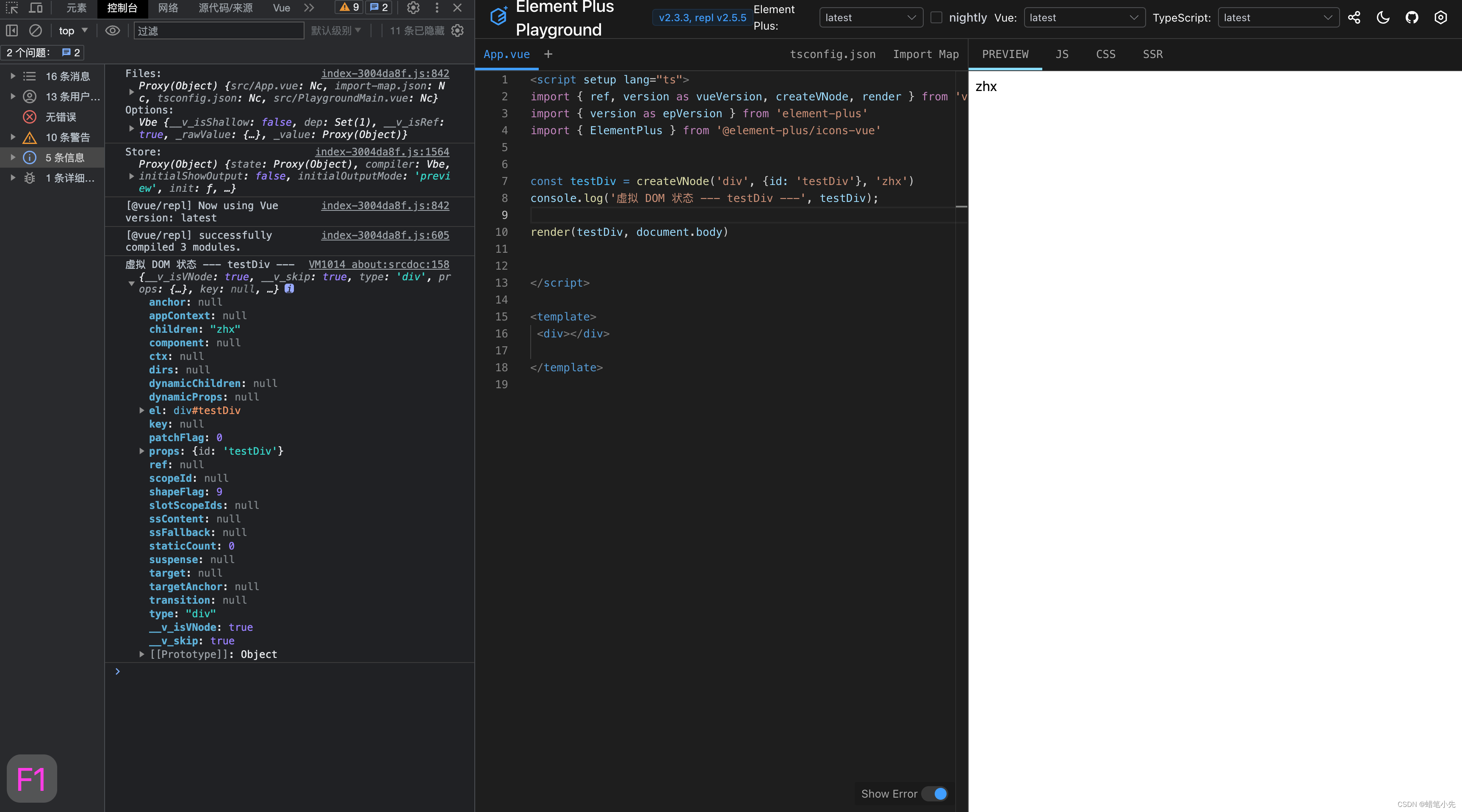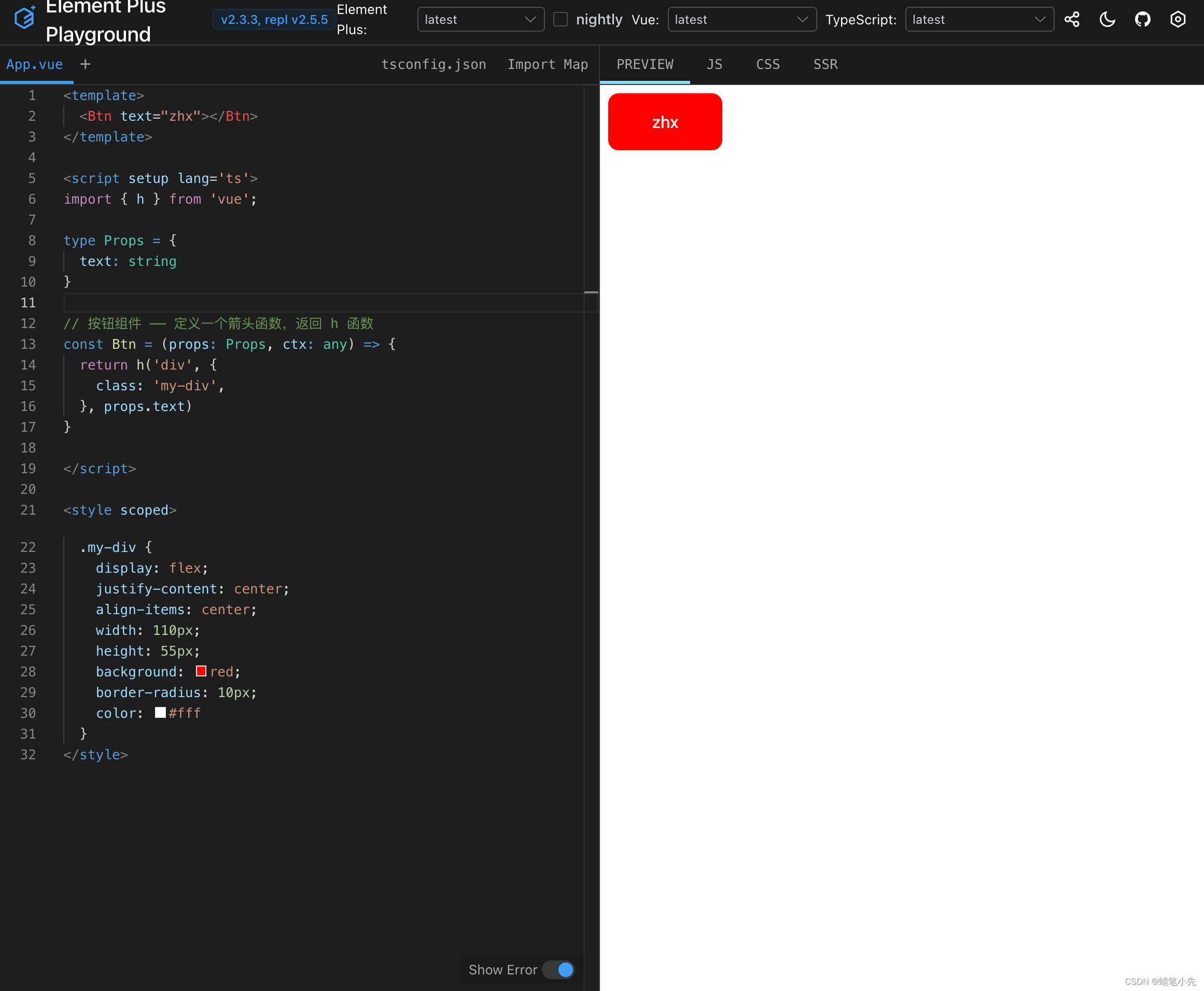1. createVNode()、render()
1.1 初步使用 createVNode()、render()
Vue3 插件当时也涉及到了 createVNode()、render()
h 函数本质上是用了 Vue 内置函数 —— createVNode()、render() 实现的
从 vue 中,引入 createVNode, render 函数
使用 createVNode() 创建虚拟 DOM 节点
使用 render() 渲染虚拟 DOM 节点
createVNode —— 创建虚拟 DOM:
@param 参数1 创建元素类型,必选
@param 参数2 创建元素属性
@paran 参数3 创建元素内容
render —— 渲染虚拟 DOM:
@param 参数1 要被渲染的虚拟 DOM,必选
@param 参数2 要渲染的位置,必选
测试代码:
<template>
<div>
</div>
</template>
<script lang="ts" setup>
import { createVNode, render } from 'vue'
/**
* createVNode —— 创建虚拟 DOM
* @param 参数1 创建元素类型,必选
* @param 参数2 创建元素属性
* @paran 参数3 创建元素内容
* @description 虚拟 DOM 创建完成后,需要使用 render 函数,才能在页面中渲染
*/
const testDiv = createVNode('div', { id: "myDivId" }, 'Lyrelion');
console.log('虚拟 DOM 状态 --- testDiv ---', testDiv);
/**
* render —— 渲染虚拟 DOM
* @param 参数1 要被渲染的虚拟 DOM,必选
* @param 参数2 要渲染的位置,必选
* @description 虚拟 DOM 创建完成后,需要使用 render 函数,才能在页面中渲染
*/
render(testDiv, document.body);
</script>
结果如下,可以看到,我给 div 添加的 id、innerHTML,在虚拟 DOM 中都体现了

1.2 h 函数源码分析
位置:packages\runtime-core\src\h.ts
// “h” 是 “createVNode” 的用户友好的版本,适用于手动编写的渲染函数
// 编译器生成的代码使用 “createVNode”,因为
// 1.它是单态的,避免了额外的呼叫开销
// 2.它允许为优化指定 patchFlags
// 没有 props 的命名槽,需要显式 “null” 以避免歧义
可以看到最后的 h 函数方法中,一直在使用 createVNode()
import {
VNode,
VNodeProps,
createVNode,
VNodeArrayChildren,
Fragment,
Text,
Comment,
isVNode
} from './vnode'
...
...
...
// “h” 是 “createVNode” 的用户友好的版本,适用于手动编写的渲染函数
// 编译器生成的代码使用 “createVNode”,因为
// 1.它是单态的,避免了额外的呼叫开销
// 2.它允许为优化指定 patchFlags
/*
// type only
h('div')
// type + props
h('div', {})
// type + omit props + children
// Omit props does NOT support named slots
h('div', []) // array
h('div', 'foo') // text
h('div', h('br')) // vnode
h(Component, () => {}) // default slot
// type + props + children
h('div', {}, []) // array
h('div', {}, 'foo') // text
h('div', {}, h('br')) // vnode
h(Component, {}, () => {}) // default slot
h(Component, {}, {}) // named slots
// 没有 props 的命名槽,需要显式 “null” 以避免歧义
h(Component, null, {})
**/
...
...
...
// Actual implementation
export function h(type: any, propsOrChildren?: any, children?: any): VNode {
const l = arguments.length
if (l === 2) {
if (isObject(propsOrChildren) && !isArray(propsOrChildren)) {
// single vnode without props
if (isVNode(propsOrChildren)) {
return createVNode(type, null, [propsOrChildren])
}
// props without children
return createVNode(type, propsOrChildren)
} else {
// omit props
return createVNode(type, null, propsOrChildren)
}
} else {
if (l > 3) {
children = Array.prototype.slice.call(arguments, 2)
} else if (l === 3 && isVNode(children)) {
children = [children]
}
return createVNode(type, propsOrChildren, children)
}
}
2. 使用 h 函数的几种方法
2.1 h 函数 接收的参数
type —— 元素的类型,必选
propsOrChildren —— 数据对象(props、attrs、dom、class、style、…)
children —— 子节点,可以包含混合的 VNode 和 字符串
除类型 type 之外,所有参数都是可选的
2.2 h 函数 使用方法
// 除类型之外的所有参数都是可选的
h('div')
h('div', { id: 'foo' })
// 属性和内容,都可以在第二个参数中使用
// Vue 会自动选择正确的分配方式
h('div', { class: 'bar', innerHTML: 'hello' })
// 可以添加 .prop 和 .attr 等修饰符
// 分别带有 “.” 和 “^” 前缀
h('div', { '.name': 'some-name', '^width': '100' })
// class、style 可以是对象,也可以是数组
h('div', { class: [foo, { bar }], style: { color: 'red' } })
// 定义事件需要加 on,如 onXxx
h('div', { onClick: () => {} })
// 子集可以是字符串
h('div', { id: 'foo' }, 'hello')
// 如果没有props,可以省略 props
h('div', 'hello')
h('div', [h('span', 'hello')])
// 子数组可以包含混合的 VNode 和 字符串
h('div', ['hello', h('span', 'hello')])
3. 通过 h 函数实现 button 组件
3.1 使用 props 接收传入组件的参数
定义一个箭头函数,该函数返回一个 h 函数
箭头函数默认接收两个参数 props、ctx,就跟 setup 接收的两个参数作用一样
第一个参数 div 就是元素类型
第二个参数 { class: ‘my-div’ } 就是 数据对象(props、attrs、dom、class、style、…)
第三个参数 props.text 子节点,此处就是一段文字
<template>
<Btn text="zhx"></Btn>
</template>
<script setup lang='ts'>
import { h } from 'vue';
type Props = {
text: string
}
// 按钮组件 —— 定义一个箭头函数,返回 h 函数
const Btn = (props: Props, ctx: any) => {
return h('div', {
class: 'my-div',
}, props.text)
}
</script>
<style scoped>
.my-div {
display: flex;
justify-content: center;
align-items: center;
width: 110px;
height: 55px;
background: red;
border-radius: 10px;
color: #fff
}
</style>

3.2 使用 emit 向组件外发送事件
emit 添加事件的时候,一定要带上 on 前缀
<template>
<Btn text="zhx" @on-click="getNum"></Btn>
</template>
<script setup lang='ts'>
import { h } from 'vue';
type Props = {
text: string
}
// 按钮组件 —— 定义一个箭头函数,返回 h 函数
const Btn = (props: Props, ctx: any) => {
return h('div', {
class: 'my-div',
onClick: () => {
ctx.emit('on-click', 123)
}
}, props.text)
}
const getNum = (num: number) => {
console.log(num);
}
</script>
3.3 使用 ctx.slots.default() 在组件内定义插槽
<template>
<Btn @on-click="getNum">
<template #default>
zhx-slots
</template>
</Btn>
</template>
<script setup lang='ts'>
import { h } from 'vue';
type Props = {
text?: string
}
// 按钮组件 —— 定义一个箭头函数,返回 h 函数
const Btn = (props: Props, ctx: any) => {
return h('div', {
class: 'my-div',
onClick: () => {
ctx.emit('on-click', 123)
}
}, ctx.slots.default())
}
const getNum = (num: number) => {
console.log(num);
}
</script>


























 1111
1111











 被折叠的 条评论
为什么被折叠?
被折叠的 条评论
为什么被折叠?










